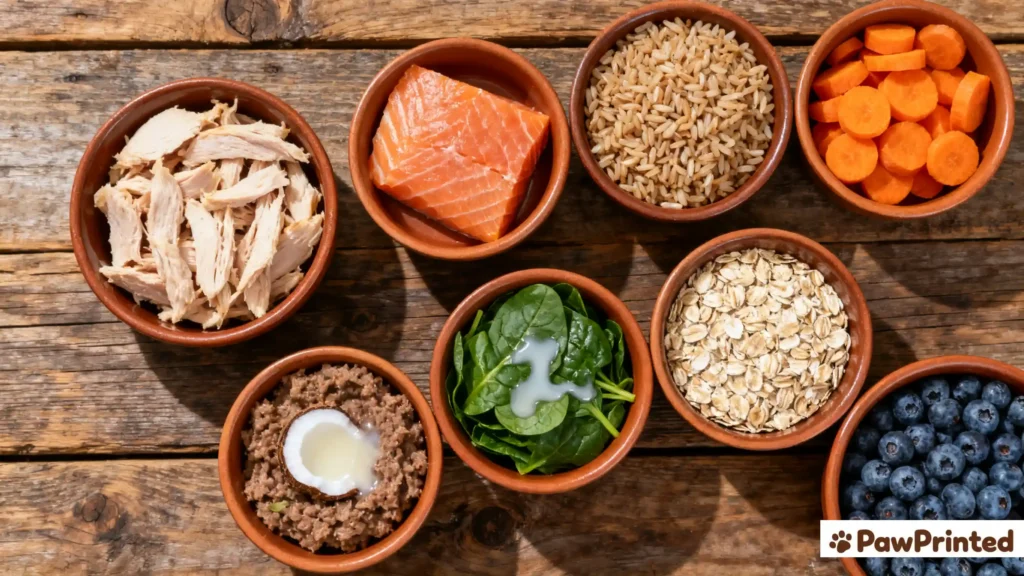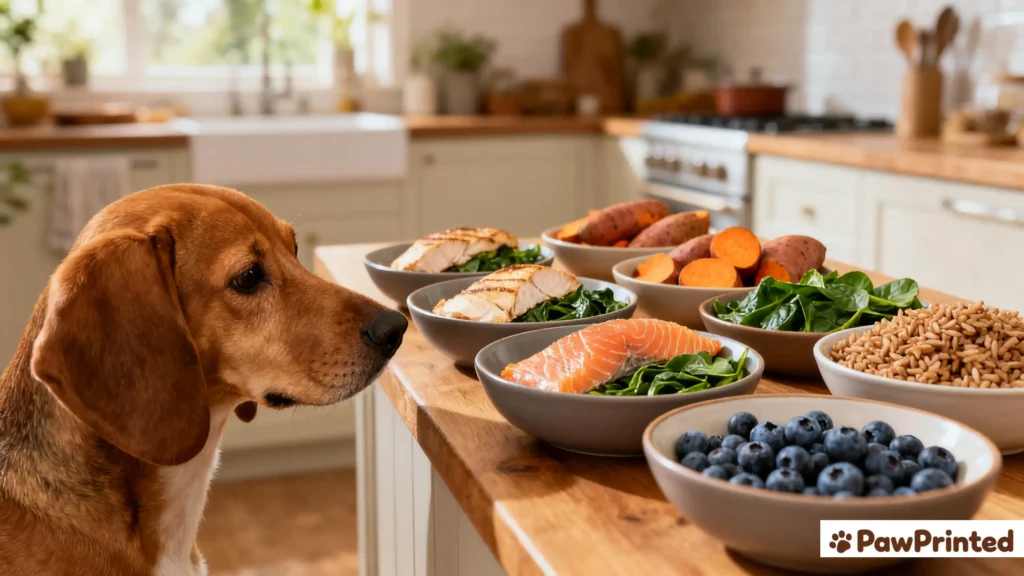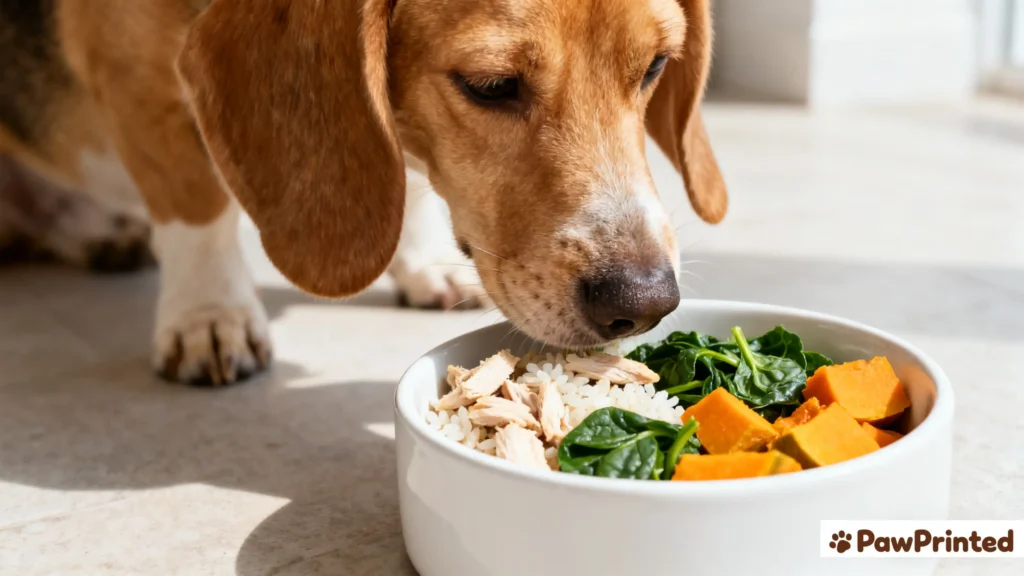I’m Emma, and this is the guide I wish I had on day one. After dozens of food logs and more than a few “why is his tummy off?” moments with Ethan, our vet helped us boil nutrition down to calm, practical choices: know your dog’s needs, change one thing at a time, and track what matters. Below is the notes-first version we now share with every family.

Red flag — call your vet: rapid weight change, repeated vomiting or diarrhea, blood in stool, persistent itch/infections, lethargy, labored breathing at rest. Nutrition is powerful, but red flags need medical eyes.
What Every Dog Needs in a Balanced Diet
Protein repairs tissue and supports immune health; look for named meats or fish first on the label. Fats (including omega-3/6) fuel daily life and keep skin/coat comfortable. Carbohydrates stabilize energy and stools when chosen thoughtfully (oats, rice, pumpkin, sweet potato). Then layer vitamins/minerals for bone, nerve, and metabolic balance.
Want an ingredient-first tour? See our hub on Ingredient-Based Dog Food for single-protein ideas (chicken, lamb, salmon, turkey) and how to rotate without chaos.
Life Stages: Puppy, Adult, Senior
Puppies run hotter: higher energy density, controlled calcium/phosphorus for safe growth, and predictable meal timing. If you’re cooking, start with gentle, simple combos and vet-approved supplements—our starter is here: Homemade Dog Food for Puppies.
Adults need balance and portion control. When switching foods, use a measured plan and watch stool/energy trends: Dog Food Transition Guide.
Seniors often benefit from joint support, protein quality, and easier textures. A slow-cooker base can be a gentle anchor on sore days: Crockpot Dog Food for Senior Dogs.

Special Diets for Sensitive Dogs
If the gut or skin is “talking,” lower variables. For recurrent loose stools or tummy upsets, start with our cornerstone hub: Sensitive Stomach & Diarrhea Guide. If itching, hot spots, or ear gunk dominate, scan our Sensitive Skin notes and consider limited-ingredient trials. Gas and bloating patterns? See Gas & Bloating Relief.
Prefer single-protein clarity (turkey, lamb, salmon) or grain decisions (whole-grain vs grain-free)? These two hubs frame the trade-offs: Ingredient-Based and Grain-Free Dog Food.
Homemade, Raw, or Kibble?
Kibble wins for convenience and consistency; pick named proteins, clear fiber sources, and an AAFCO nutritional adequacy statement. Wet food adds moisture and aroma—useful for picky or dental-sensitive pups. Homemade offers control but needs a plan: start with limited ingredients and add vet-approved micronutrient support; see Homemade for Sensitive Stomach and Homemade Limited-Ingredient. Curious about raw for youngsters? Read Raw Dog Food for Puppies before you leap.
Tip: Change one lever at a time (protein, texture, or brand), keep it steady for 7–10 days, and log weight, stools, energy. Small signals beat guesswork.

How to Read a Dog Food Label (Quick Wins)
- First five ingredients: named meats/fish first; avoid vague “meat by-product” language if quality is your priority.
- Fiber & stool quality: beet pulp, pumpkin, oats, rice often steady the gut; ultra-high fiber can backfire for some dogs.
- AAFCO statement: “complete & balanced” for your dog’s life stage (growth, adult maintenance, all life stages).
- Allergen watch: if you’re trialing LID, prune extras (multiple proteins, dairy, many botanicals) until symptoms settle.
When We Go Homemade (Safely)
Our gentle pattern: one protein + one carb + one veg, cooked simply and cooled fully. Then we layer vet-approved micronutrients per recipe. For inspiration, try Crockpot Dog Food (base method) or the skin-soothing mix in Homemade for Skin Allergies.
Keep Exploring the Right Next Article

Option/Why/Best For
| Feature | Ingredient-Based Dog Food | Generic Dog Food |
|---|---|---|
| Main Focus | Specific protein or ingredient focus (e.g., lamb, salmon, turkey) | Broad recipes with mixed proteins and fillers |
| Suitability | Ideal for allergies, sensitivities, and tailored nutrition | Works for most average dogs without special needs |
| Transparency | Clear labeling (one highlighted protein or carb source) | Often “meat meal” or mixed sources without details |
| Digestibility | Usually higher, less chance of bloating or gas | May contain corn, soy, or fillers harder to digest |
| Cost | Higher (premium niche formulas) | More budget-friendly, widely available |
FAQs
Do dogs really need carbohydrates?
Dogs can utilize carbs well, and gentle sources help stool quality and energy steadiness. If you’re troubleshooting GI upset, see our Sensitive Stomach & Diarrhea Guide and start with predictable carbs like rice, oats, or pumpkin.
Can homemade food replace kibble completely?
Yes, but only with a complete plan for micronutrients and calories. We recommend beginning with limited-ingredient recipes and progressing with your vet’s input. Practical starters: Homemade for Sensitive Stomach and Homemade Limited-Ingredient.
Is grain-free better?
Not automatically. Many dogs do well on whole-grain diets; some benefit from grain-free during elimination trials. Focus on how your dog responds. Our balanced overview: Grain-Free Dog Food.
What human foods are unsafe for dogs?
Grapes/raisins, chocolate, xylitol, onions/garlic, alcohol, and fatty scraps top the list. If a food trial is running, keep treats simple and measured—our Transition Guide explains how to control variables.
If you prefer a single starting point, open our Health-Specific Dog Food hub and choose the page that matches your dog’s top symptom. One clear step is better than five guesses.

